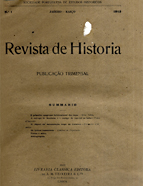

................................
The idea of creating a journal was revived the following year, 1911, already within the general framework of the SPEH programme, which had then been made public. The ‘programme circular’ also called on ‘all
Portuguese professionals in the historical sciences”, with the aim of bringing together “all these scattered efforts and ensuring that each author, for a minimal fee, would receive publicity, an audience and critical discussion” (Boletim da Sociedade de Geografia, 1911, p. 120). Among the many initiatives planned for this associative undertaking was the creation of what would become the RH.
One cannot fail to note the apparent simplicity of the title of this periodical. In fact, by choosing the name “História” (History), the founders of the SPEH managed, from the outset, to dispel any restrictive concerns. Put in this way, it allowed for the inclusion of any line of research that proposed a historical horizon in its study, be it political, social, military, religious, literary or other. Despite its relatively short life, in the Portuguese context, RH established itself as one of the most significant history journals of its time, a fact well illustrated by the praise it received in a 1914 decree signed by the then Minister of Public Instruction, Sobral Cid. In our view, it assumed a position of relative prominence. For example, in a brief comparison with another contemporary publication, Arquivo Histórico (1903-21), and although we understand that the two periodicals had different objectives, RH had a modern, more ambitious, balanced and relatively innovative structure in the Portuguese landscape, consisting of three main sections, “Articles”, “Facts and Notes” (a section that was highly original, and which we could call historical journalism) and “Bibliography”. It should be noted, however, that this structure was clearly inspired by a foreign model, the Revue de Synthèse Historique (1900), then directed by Henri Berr. A reference author in those years for Fidelino de Figueiredo, an attempt was made to guide the RH in this direction, towards an approach based on synthesis in historiographical construction. In an interesting and still useful brochure published by the SPEH itself with the aim of listing the history publications of the time, we note a conspicuous self-assessment: “The Revista de História seeks to reconcile the function of archiving materials with that of synthesis, promoting the dissemination of sources and the construction of history. It is also interested in the theoretical problems of historical sciences and the methodology of their teaching” (Revistas Portuguesas de História e Ciências Correlativas, 1915, p. 14).
This work is financed by national funds through FCT - Foundation for Science and Technology, I.P, in the scope of the projects UIDB/04311/2020 and UIDP/04311/2020.
